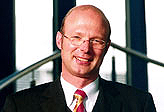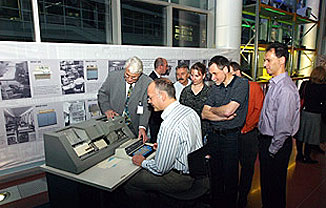In this interview, Kurt Servatius, CEO of Allianz's German IT services provider AGIS, and Lex de Grunt, CIO of Allianz Netherlands, talk about the exhibition and future IT trends.
"IT infrastructure will become more international"
Dr. Servatius, the current "Bits and Bytes for Business" exhibition demonstrates how EDP has changed at Allianz over the last 50 years. Can you give us a general idea of what EDP was like some 50 years ago?
Kurt Servatius: 50 years ago, early commercial systems required expensive hardware and highly specialized staff to develop the necessary software. Applications performed very specific tasks, such as running statistical analyses or calculating tariffs.
The introduction of EDP at Allianz in the 1950s also meant new requirements in IT expertise as well as new career opportunities. Keep in mind, in those days we didn't have IT specialists as we have today. Rather, it was our own insurance staff who developed into IT experts over time, as our organizational processes increasingly became computerized.
Data was usually entered using punched paper cards. Data storage was on paper tape and later on magnetic tape. Readily accessible memory storage was not yet cost-effective and processing results were only available on print-outs.
Needless to say, EDP-based outcome was relatively expensive, slow and instable, especially compared to today's standards.

What were the main drivers for change which have given us the EDP capabilities we have today?
Servatius: Standardization is largely responsible for the change so far. Today, hardware is standardized with compatible chips, and hardware components can be combined as needed. Data storage is also standardized. Common file formats can be shared by large main-frame and desk-top computers alike. This means that users can work online, entering and validating data in real-time.
Software that has been standardized for core processes in financial services is increasingly available. But even specialized software, developed and operated by technicians, use common conventions and interfaces.
This standardization, as well as the exponential speed and capacity growth for both hardware and computer networks during the last decades, have opened up enormous opportunities for companies like Allianz to continuously and cost-effectively improve their IT infrastructures over time.

At the exhibition, Allianz staff were amused by the card puncher
Reviewing the history of IT infrastructure at Allianz, what have been the main milestones of progress?
Servatius: In 1956, Allianz installed its first mainframe computer. At the time, the IBM 650 (a magnetic drum data processing machine) was the heart of Allianz's new data center in Munich. In fact, it was the first main-frame computer of the European insurance industry.
Over the following three decades, IT investments in our German insurance business grew continuously. During this time, Allianz was always in anticipation of the next generation of computing. Our sheer size dictated that we achieve and maintain state-of-the-art.
In the late 1990's, Allianz began centralizing various data centers throughout Germany. In 1998, Allianz established AGIS as its own IT services provider in Germany. This also brought the IT- infrastructure departments of three separate Allianz entities in Germany under one roof: Allianz Sach (property & casualty), Allianz Leben (life insurance) and Allianz Private Krankenversicherung (health insurance).
With the integration of Dresdner Bank into Allianz in 2001, intensive cooperation began between AGIS and the Bank's IT service provider, DREGIS. By January 2002, AGIS and DREGIS were unified under a single management structure, with the objective to create a standardized cost-efficient system landscape for both insurance and banking through the merger.
A standardized IT infrastructure for Germany is already well advanced. Do you also see this kind of IT organization going beyond national borders?
Servatius: It's already happening, and I anticipate further internationalization. Allianz subsidiaries in Austria and Switzerland are already using our Munich-based data center. And for some time now, foreign subsidiaries of Dresdner Bank have been using a central banking system in Germany, which is also run by AGIS.When designing enterprise architecture, IT should not only be seen as a cost center. More importantly, IT is a competitive factor.
There are three components to good IT infrastructure: quality, security and cost-efficiency. These are achieved through economies of scale, as well as standardizing and automating IT infrastructure as much as possible. In other words, we must industrialize IT infrastructure, also for our internal clients in other countries. If we do that, we can improve our overall competitiveness in the market.
Such is already the case with our subsidiary Allianz Netherlands which wants to integrate its mainframe infrastructure into our Munich data center.
Mr. de Grunt, as CIO of Allianz Netherlands, how does using Allianz's IT infrastructure in Germany make sense for your company?
Lex de Grunt: Given the standardization of IT infrastructure over the last decades, it is no longer necessary to own and operate our own mainframe architecture, provided that a state-of-the-art alternative is readily available to us. In addition, network speeds made possible by broadband technology give us real-time access to the data center in Munich.
The potential impact on the bottom line is considerable too. This does not only mean shorter time to market with new products, despite ever-changing IT infrastructure and application requirements. It also means major IT cost-savings to Allianz Netherlands, as well as shared costs for AGIS. This in turn creates further economies of scale for the entire Group.

Would this have any effect on your company's individual business applications?
de Grunt: I don't expect it to. While core processes in financial services can be standardized to a certain extent, most applications must be specifically-tailored to a given insurance product in its unique market. This has several reasons, for example, each country has different regulatory requirements, and every company has a unique history including mergers with other companies and their legacy systems.
One exception would be the pan-European insurance and asset management products which are on the rise. In 2006, Allianz launched several of these products to better serve the needs of multinational corporate clients. For these, I imagine that special applications will be developed to manage the international business. Yet, before applications can be standardized and run across borders, a standardized underlying IT infrastructure is required.
What has IT development at Allianz meant to your end-customers?
de Grunt: At the end of the day, most insurance customers don't think about the IT we put into our business, and why should they?
Yet, in fact, IT developments over the last fifty years have continuously improved not only our ability to process massive amounts of data, but also to run our business applications more quickly and reliably. This, in turn, has meant faster reaction times to the customer, for example, when issuing an insurance policy or processing claims.
Today, a partially-common IT infrastructure already allows our sales force to gain a better overview of a customer’s contracts. This enables more comprehensive customer advice, for example, based on what he already has and what he potentially needs. This integrated overview of the customer and his accounts are the key to our integrated financial services provider approach which we have already established in several markets.
In the end, customers see fast and competent service, and not necessarily the IT infrastructure which supports our business applications. IT infrastructure is best when it performs without being noticed.
As with all content published on this site, these statements are subject to our Forward Looking Statement disclaimer.
Link to the disclaimer